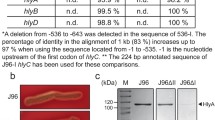Abstract
Bacterial 2′-O-methyltransferase TlyA methylates either both nucleotide C1409 of 16S rRNA and C1920 of 23S rRNA or only the C1920. Both ribosomal methylations increase bacterial susceptibility to ribosome-targeting antibiotics capreomycin and viomycin. However, TlyA has been suggested to also function as a hemolysin. Here, heterologous expression of TlyA from six diverse bacteria (including Mycobacterium tuberculosis and M. smegmatis) was found to increase hemolytic ability in the Escherichia coli host. Characterizing E. coli strains expressing mycobacterial TlyA with mutated rRNA recognition domain and impaired rRNA methylations showed that the abolished C1409 methylation altogether with significantly reduced C1920 methylation did not affect E. coli hemolytic activity. Thus, the increased bacterial hemolytic function is not likely a consequence of TlyA-mediated methylations of the ribosome. Purified water-soluble TlyA showed a weak concentration-dependent hemolysis in vitro. Therefore, the TlyA isoform alone is not a potent hemolysin. The results suggested that the bacterial hemolytic function might relate to the over-expression of TlyA and its interaction to other non-ribosomal target that is associated with the hemolytic ability.


Similar content being viewed by others
Abbreviations
- SAM:
-
S-Adenosyl-methionine
- MIC:
-
Minimum inhibitory concentration
References
Aravind L, Koonin EV (1999) Novel predicted RNA-binding domains associated with the translation machinery. J Mol Evol 48(3):291–302
Arenas NE, Salazar LM, Soto CY, Vizcaino C, Patarroyo ME, Patarroyo MA, Gomez A (2011) Molecular modeling and in silico characterization of Mycobacterium tuberculosis TlyA: possible misannotation of this tubercle bacilli-hemolysin. BMC Struct Biol 11:16. doi:10.1186/1472-6807-11-16
Bradford MM (1976) A rapid and sensitive method for the quantitation of microgram quantities of protein utilizing the principle of protein-dye binding. Anal Biochem 72:248–254
Deshpande RG, Khan MB, Bhat DA, Navalkar RG (1997) Isolation of a contact-dependent haemolysin from Mycobacterium tuberculosis. J Med Microbiol 46(3):233–238
Ermolenko DN, Spiegel PC, Majumdar ZK, Hickerson RP, Clegg RM, Noller HF (2007) The antibiotic viomycin traps the ribosome in an intermediate state of translocation. Nat Struct Mol Biol 14(6):493–497. doi:10.1038/nsmb1243
Feder M, Pas J, Wyrwicz LS, Bujnicki JM (2003) Molecular phylogenetics of the RrmJ/fibrillarin superfamily of ribose 2′-O-methyltransferases. Gene 302(1–2):129–138
Gomez A, Mve-Obiang A, Vray B, Rudnicka W, Shamputa IC, Portaels F, Meyers WM, Fonteyne PA, Realini L (2001) Detection of phospholipase C in nontuberculous mycobacteria and its possible role in hemolytic activity. J Clin Microbiol 39(4):1396–1401. doi:10.1128/JCM.39.4.1396-1401.2001
Gregory ST, Carr JF, Rodriguez-Correa D, Dahlberg AE (2005) Mutational analysis of 16S and 23S rRNA genes of Thermus thermophilus. J Bacteriol 187(14):4804–4812. doi:10.1128/JB.187.14.4804-4812.2005
Hanahan D (1983) Studies on transformation of Escherichia coli with plasmids. J Mol Biol 166(4):557–580
Hansen LH, Kirpekar F, Douthwaite S (2001) Recognition of nucleotide G745 in 23 S ribosomal RNA by the rrmA methyltransferase. J Mol Biol 310(5):1001–1010. doi:10.1006/jmbi.2001.4836
Johansen SK, Maus CE, Plikaytis BB, Douthwaite S (2006) Capreomycin binds across the ribosomal subunit interface using tlyA-encoded 2′-O-methylations in 16S and 23S rRNAs. Mol Cell 23(2):173–182. doi:10.1016/j.molcel.2006.05.044
King CH, Mundayoor S, Crawford JT, Shinnick TM (1993) Expression of contact-dependent cytolytic activity by Mycobacterium tuberculosis and isolation of the genomic locus that encodes the activity. Infect Immun 61(6):2708–2712
Martino MC, Stabler RA, Zhang ZW, Farthing MJ, Wren BW, Dorrell N (2001) Helicobacter pylori pore-forming cytolysin orthologue TlyA possesses in vitro hemolytic activity and has a role in colonization of the gastric mucosa. Infect Immun 69(3):1697–1703. doi:10.1128/IAI.69.3.1697-1703.2001
Maus CE, Plikaytis BB, Shinnick TM (2005) Molecular analysis of cross-resistance to capreomycin, kanamycin, amikacin, and viomycin in Mycobacterium tuberculosis. Antimicrob Agents Chemother 49(8):3192–3197. doi:10.1128/AAC.49.8.3192-3197.2005
Maus CE, Plikaytis BB, Shinnick TM (2005) Mutation of tlyA confers capreomycin resistance in Mycobacterium tuberculosis. Antimicrob Agents Chemother 49(2):571–577. doi:10.1128/AAC.49.2.571-577.2005
Monshupanee T, Gregory ST, Douthwaite S, Chungjatupornchai W, Dahlberg AE (2008) Mutations in conserved helix 69 of 23S rRNA of Thermus thermophilus that affect capreomycin resistance but not posttranscriptional modifications. J Bacteriol 190(23):7754–7761. doi:10.1128/JB.00984-08
Monshupanee T, Johansen SK, Dahlberg AE, Douthwaite S (2012) Capreomycin susceptibility is increased by TlyA-directed 2′-O-methylation on both ribosomal subunits. Mol Microbiol 85(6):1194–1203
Muir S, Koopman MB, Libby SJ, Joens LA, Heffron F, Kusters JG (1992) Cloning and expression of a Serpula (Treponema) hyodysenteriae hemolysin gene. Infect Immun 60(2):529–535
Rahman A, Srivastava SS, Sneh A, Ahmed N, Krishnasastry MV (2010) Molecular characterization of tlyA gene product, Rv1694 of Mycobacterium tuberculosis: a non-conventional hemolysin and a ribosomal RNA methyltransferase. BMC Biochem 11:35. doi:10.1186/1471-2091-11-35
Sambrook J, Fritsch EF, Maniatis T (eds) (1989) Molecular cloning: a laboratory manual, 2nd edn. Cold Spring Harbor laboratory press, New York
Stanley RE, Blaha G, Grodzicki RL, Strickler MD, Steitz TA (2010) The structures of the anti-tuberculosis antibiotics viomycin and capreomycin bound to the 70S ribosome. Nat Struct Mol Biol 17(3):289–293. doi:10.1038/nsmb.1755
Stern S, Moazed D, Noller HF (1988) Structural analysis of RNA using chemical and enzymatic probing monitored by primer extension. Methods Enzymol 164:481–489
Wang H, Wu Y, Ojcius DM, Yang XF, Zhang C, Ding S, Lin X, Yan J (2012) Leptospiral hemolysins induce proinflammatory cytokines through Toll-like receptor 2-and 4-mediated JNK and NF-kappaB signaling pathways. PLoS One 7(8):e42266. doi:10.1371/journal.pone.0042266PONE-D-12-07896
Wren BW, Stabler RA, Das SS, Butcher PD, Mangan JA, Clarke JD, Casali N, Parish T, Stoker NG (1998) Characterization of a haemolysin from Mycobacterium tuberculosis with homology to a virulence factor of Serpulina hyodysenteriae. Microbiology 144(Pt 5):1205–1211
Acknowledgments
The author thanks Dr. Stephen Douthwaite for the E. coli strains and Dr. Robert Butcher for English proofreading and critical reading. This study was supported by the Thailand Research Fund (Grant MRG 5480109 to T.M.) and the Ratchadapisek Somphot Project of Chulalongkorn University.
Author information
Authors and Affiliations
Corresponding author
Electronic supplementary material
Below is the link to the electronic supplementary material.
Rights and permissions
About this article
Cite this article
Monshupanee, T. Increased Bacterial Hemolytic Activity is Conferred by Expression of TlyA Methyltransferase but not by its 2′-O-methylation of the Ribosome. Curr Microbiol 67, 61–68 (2013). https://doi.org/10.1007/s00284-013-0332-7
Received:
Accepted:
Published:
Issue Date:
DOI: https://doi.org/10.1007/s00284-013-0332-7




